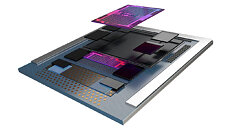
QNAP Launches the TS-h1290FX Tower NAS Powered by AMD EPYC, with 25 GbE
QNAP Systems, Inc., a leading computing, networking, and storage solution innovator, today launched the TS-h1290FX NAS. Providing QNAP's first PCIe 4.0 and U.2 NVMe/SATA all-flash NAS in a tower form factor, the TS-h1290FX excels in the most demanding work environments such as collaborative high-resolution video workflows. Featuring AMD EPYC 8/16-core processors, built-in 25 GbE and 10GbE connectivity, PCIe Gen 4 expansion, and up to petabyte-scale storage capacity, the TS-h1290FX provides up to 816K/318K iSCSI 4K random read/write IOPS for tackling data-intensive and latency-sensitive applications, such as large media file transfer, real-time editing of 4K/8K media, and virtualization applications.
"Modern businesses and studios shouldn't need to dedicate entire rooms to accommodate hot and loud servers, and that's where the TS-h1290FX comes in. Contained within a unique tower form factor and utilizing quiet cooling is exceptional performance driven by a server-grade processor, all-flash U.2 NVMe SSD storage, and QNAP's enterprise-grade QuTS hero operating system," said Jason Hsu, Product Manager of QNAP, adding "the TS-h1290FX is a remarkable storage solution that provides exceptional power to deal with the modern demands of businesses and studios - including high-resolution media editing and online collaborative workflows."
"Modern businesses and studios shouldn't need to dedicate entire rooms to accommodate hot and loud servers, and that's where the TS-h1290FX comes in. Contained within a unique tower form factor and utilizing quiet cooling is exceptional performance driven by a server-grade processor, all-flash U.2 NVMe SSD storage, and QNAP's enterprise-grade QuTS hero operating system," said Jason Hsu, Product Manager of QNAP, adding "the TS-h1290FX is a remarkable storage solution that provides exceptional power to deal with the modern demands of businesses and studios - including high-resolution media editing and online collaborative workflows."











































